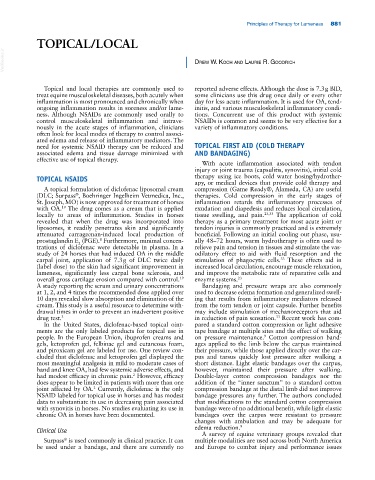Page 915 - Adams and Stashak's Lameness in Horses, 7th Edition
P. 915
Principles of Therapy for Lameness 881
TOPICAL/LOCAL
VetBooks.ir Drew w. Koch anD Laurie r. GooDrich
Topical and local therapies are commonly used to reported adverse effects. Although the dose is 7.3 g BID,
treat equine musculoskeletal diseases, both acutely when some clinicians use this drug once daily or every other
inflammation is most pronounced and chronically when day for less acute inflammation. It is used for OA, tend-
ongoing inflammation results in soreness and/or lame- initis, and various musculoskeletal inflammatory condi-
ness. Although NSAIDs are commonly used orally to tions. Concurrent use of this product with systemic
control musculoskeletal inflammation and intrave- NSAIDs is common and seems to be very effective for a
nously in the acute stages of inflammation, clinicians variety of inflammatory conditions.
often look for local modes of therapy to control associ-
ated edema and release of inflammatory mediators. The
need for systemic NSAID therapy can be reduced and TOPICAL FIRST AID (COLD THERAPY
associated edema and tissue damage minimized with AND BANDAGING)
effective use of topical therapy.
With acute inflammation associated with tendon
injury or joint trauma (capsulitis, synovitis), initial cold
TOPICAL NSAIDS therapy using ice boots, cold water hosing/hydrother-
apy, or medical devices that provide cold therapy and
A topical formulation of diclofenac liposomal cream compression (Game Ready®, Alameda, CA) are useful
(DLC; Surpass , Boehringer Ingelheim Vetmedica, Inc., therapies. Cold compression in the early stages of
®
St. Joseph, MO) is now approved for treatment of horses inflammation retards the inflammatory processes of
with OA. The drug comes as a cream that is applied exudation and diapedesis and reduces local circulation,
19
locally to areas of inflammation. Studies in horses tissue swelling, and pain. 23,33 The application of cold
revealed that when the drug was incorporated into therapy as a primary treatment for most acute joint or
liposomes, it readily penetrates skin and significantly tendon injuries is commonly practiced and is extremely
attenuated carrageenan‐induced local production of beneficial. Following an initial cooling out phase, usu-
prostaglandin E (PGE). Furthermore, minimal concen- ally 48–72 hours, warm hydrotherapy is often used to
8
2
trations of diclofenac were detectable in plasma. In a relieve pain and tension in tissues and stimulate the vas-
study of 24 horses that had induced OA in the middle odilatory effect to aid with fluid resorption and the
33
carpal joint, application of 7.3 g of DLC twice daily stimulation of phagocytic cells. These effects aid in
(label dose) to the skin had significant improvement in increased local circulation, encourage muscle relaxation,
lameness, significantly less carpal bone sclerosis, and and improve the metabolic rate of reparative cells and
overall gross cartilage erosion compared with control. enzyme systems. 23
19
A study reporting the serum and urinary concentrations Bandaging and pressure wraps are also commonly
at 1, 2, and 4 times the recommended dose applied over used to decrease edema formation and generalized swell-
10 days revealed slow absorption and elimination of the ing that results from inflammatory mediators released
cream. This study is a useful resource to determine with- from the torn tendon or joint capsule. Further benefits
drawal times in order to prevent an inadvertent positive may include stimulation of mechanoreceptors that aid
drug test. 3 in reduction of pain sensation. Recent work has com-
33
In the United States, diclofenac‐based topical oint- pared a standard cotton compression or light adhesive
ments are the only labeled products for topical use in tape bandage at multiple sites and the effect of walking
9
people. In the European Union, ibuprofen creams and on pressure maintenance. Cotton compression band-
gels, ketoprofen gel, felbinac gel and cutaneous foam, ages applied to the limb below the carpus maintained
and piroxicam gel are labeled for use. One review con- their pressure, while those applied directly over the car-
cluded that diclofenac and ketoprofen gel displayed the pus and tarsus quickly lost pressure after walking a
most meaningful analgesia in mild to moderate cases of short distance. Light elastic bandages over the carpus,
hand and knee OA, had few systemic adverse effects, and however, maintained their pressure after walking.
2
had modest efficacy in chronic pain. However, efficacy Double‐layer cotton compression bandages nor the
does appear to be limited in patients with more than one addition of the “inner sanctum” to a standard cotton
2
joint affected by OA. Currently, diclofenac is the only compression bandage at the distal limb did not improve
NSAID labeled for topical use in horses and has modest bandage pressures any further. The authors concluded
data to substantiate its use in decreasing pain associated that modifications to the standard cotton compression
with synovitis in horses. No studies evaluating its use in bandage were of no additional benefit, while light elastic
chronic OA in horses have been documented. bandages over the carpus were resistant to pressure
changes with ambulation and may be adequate for
Clinical Use edema reduction. 9
A survey of equine veterinary groups revealed that
®
Surpass is used commonly in clinical practice. It can multiple modalities are used across both North America
be used under a bandage, and there are currently no and Europe to combat injury and performance issues

